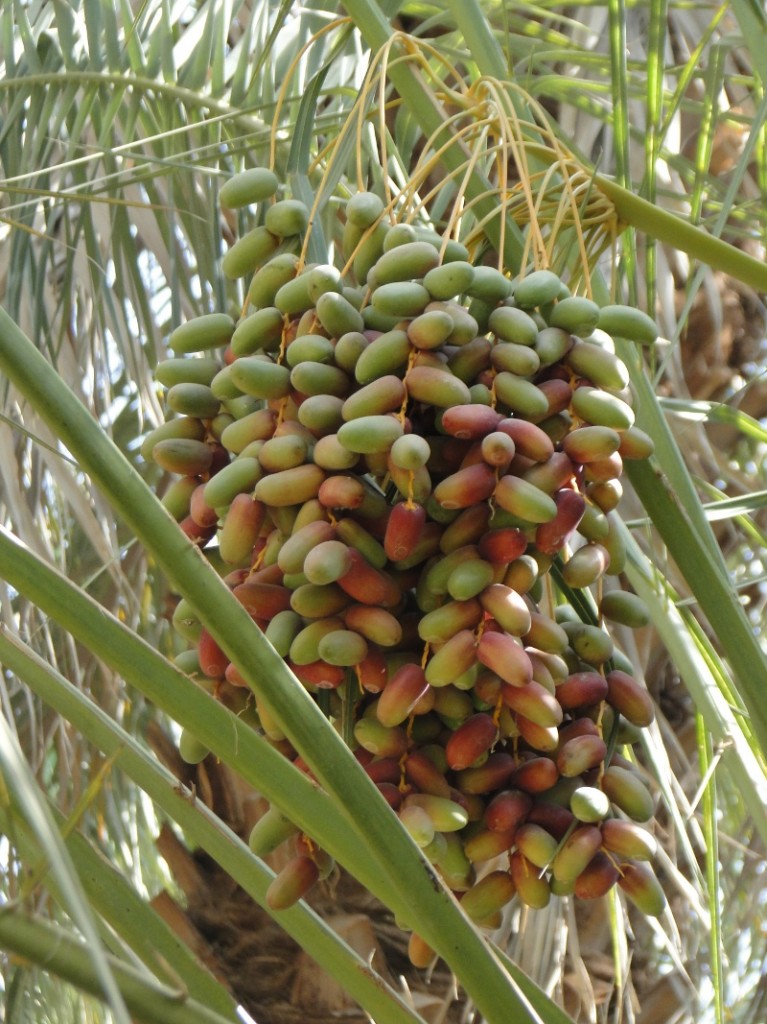My research explores the genetic and morphological diversity of Saudi Arabian date palms.
Dates are a key crop and cultural icon of Saudi Arabia. My PhD project is to identify date palm (Phoenix dactylifera L.) cultivars grown in Saudi Arabia, and to detect the confusion in nomenclature intra-cultivar, funded by the Ministry of Higher Education in the Kingdom of Saudi Arabia.
Phoenix dactylifera L. fruits have a high nutritional value while being a very important crop in the Middle East and Africa. There are about 5000 date cultivars worldwide but Saudi Arabia is the second largest producer, with more than 450 cultivars. There is a need to unify the naming of varieties formally and scientifically, in the respective countries, to ensure consistent nomenclature, as well as the importance of conservation of their genetic diversity, and recording of them before extinction. Discrimination among closely related date cultivars is extremely difficult; the first attempts were based on the morphological characteristics of fruits, usually not possible until fruiting (5-7 years), often influenced by environmental conditions, and changes during the growing stages. However, vegetative characteristics are more reliable in distinguishing between date palm varieties, and were less affected by environmental conditions. Recently, there has been an increase in DNA fingerprinting applications.
This project includes extensive collection of samples of fresh palm leaves and fruits, access to different regions and imaging palm in the field. A combined study of morphological characteristics and genetic analysis for the data of these strains is being carried out using modern molecular techniques and preparation of an electronic key based on this data.
During my previous studies in the biological sciences and plant diversity I received training on field trips, which enriched my experiences, helping me to endure hardship and challenges that I had during sample collection and the study of palm in its natural environment; in dry areas and under harsh climatic conditions in the oases and desert.
The study at the University of Reading provided me with a good environment in which to participate in scientific seminars, follow useful courses and make contact with experts in my field, all of this has helped to enrich my scientific background. In addition, my membership of some scientific societies; such as The Genetics Society and Date Palm Friends Society have been extremely rewarding.
Recently I have been developing and screening new gender specific markers using the genetic map of Mathew et al. 2014.
My hope is to contribute to the conservation of genetic strains of these varieties, registration of the unique patterns, helping to establish a library of their genetic information.




We buy Medjool Dates from USDA Farms in Bard, CA area USA. They are delicious. Do you have any commerical suggestions for people in the USA? Just a few to check out?
Dear colleague,
I have the great pleasure to inform you that the International Training program on methods of morphological and architectural measures on the date palm : modeling and computer simulation will be held from 11 to 15 November 2013 Ouarzazate, Morocco.
Best regards
Elhoumaizi M. A
Prof. Med Aziz ELHOUMAIZI
University Mohammed 1st
Faculty of Sciences, Department of Biology
P.O.Box : 717 oujda 60000, Morocco
Tel : +212666013757
Fax : +212536500603
E-mail : elhoumaizi@yahoo.fr
Please don’t print this e-mail unless you really need to!
I am a farmer from india,Rajasthan.
I have planted few plants of medjhool cultivar and i have a doubt that it is medjhool variety.
generally Medjhool cultivar Fruits color are green at immature then it turns yellow i guess and then finally ripens to brownish color.
But in plants at my farm the Fruits color are green at immature then it turns red or dark color directly, no yellow color stage. Is it possible that its medjhool?
Kindly reply.
Nishant Chahan
Farmer
India
Dear Nishant, thank you for your question. As i know, Medjool fruits in ‘bisr’ stage have a yellow-orange color, then turns to reddish-amber at rutab (mature) stage, or might be a reddish, or brown color, i wish that was a helpful, Widad.
Sir,
Thank you for your reply, it was really helpful.
Now i think may be i will go for DNA finger print test.
But I don`t have original medjhool DNA sample or DNA squence for comparative analysis.
Can you please mail me any DNA finger print of medjhool cultivar or any published paper which have Medjhool DNA sequenced. So i can get a result , if the plants at my farm are medjool or something else. I tried a lot to get DNA sequence of medjhool in WEB. But i could not get it.
When i bought the plant 4 years past the seller sold me as medjhool .So, if i had been cheated.
i need proof to challenge the seller.As i have mentioned in last conversation that, looking at fruit Morphology i am pretty much sure that its not medjhool.
kindly help.
Thank you,
Regards,
Nishant
Pingback: Ship of the desert docks at RNG | Culham Research Group
kindly reply what further i can do?
Pingback: The Date Palm: A Special Plant from the Old World | Tropical Biodiversity
Pingback: 2014 Advent Botany – Day 21 – Dates (Phoenix dactylifera) | Culham Research Group
Pingback: #Advent Botany – the full story! | Dr M Goes Wild
sir,
If you could (via mail)send me some primer sequence which i can use for cultivar identification in medjool plants.
regards
Nishant